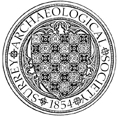Abbey Lodge, Chertsey
Continuation of the watching brief by R Poulton of SCAU. No other features of interest were revealed, with much of the site appearing to have been disturbed considerably in the post-dissolution period.

Watching brief by N Shaikhley and N Marples of SCAU during redevelopment of the car park. The redevelopment comprised mostly topsoil removal and revealed a variety of modern inclusions, but no archaeological features. A collection of struck and calcined flint recovered from the topsoil, has been broadly dated to the Neolithic or Bronze Age.